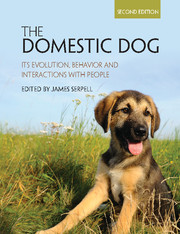Book contents
- Frontmatter
- Dedication
- Contents
- List of contributors
- 1 Introduction
- PART I ORIGINS AND EVOLUTION
- PART II BEHAVIOR, COGNITION AND TRAINING
- 5 Genetics of dog behavior
- 6 Becoming a dog: Early experience and the development of behavior
- 7 Breed and gender differences in dog behavior
- 8 Dog social behavior and communication
- 9 Ethology, ecology and epidemiology of canine aggression
- 10 Social cognition and emotions underlying dog behavior
- 11 The learning dog: A discussion of training methods
- 12 Dogs in today's society: The role of applied animal behavior
- PART III DOG-HUMAN INTERACTIONS
- PART IV LIFE ON THE MARGINS
- Index
- Plate section
- References
8 - Dog social behavior and communication
from PART II - BEHAVIOR, COGNITION AND TRAINING
Published online by Cambridge University Press: 30 December 2016
- Frontmatter
- Dedication
- Contents
- List of contributors
- 1 Introduction
- PART I ORIGINS AND EVOLUTION
- PART II BEHAVIOR, COGNITION AND TRAINING
- 5 Genetics of dog behavior
- 6 Becoming a dog: Early experience and the development of behavior
- 7 Breed and gender differences in dog behavior
- 8 Dog social behavior and communication
- 9 Ethology, ecology and epidemiology of canine aggression
- 10 Social cognition and emotions underlying dog behavior
- 11 The learning dog: A discussion of training methods
- 12 Dogs in today's society: The role of applied animal behavior
- PART III DOG-HUMAN INTERACTIONS
- PART IV LIFE ON THE MARGINS
- Index
- Plate section
- References
Summary
Introduction
The success of the domestic dog as a species depends upon its ability to interact socially with members of its own species and, crucially, with humankind. Effective interaction depends upon both a repertoire of signals whereby social intentions can be expressed, and also the cognitive ability to interpret the behavior of others. For the dog, both of these abilities must inevitably be derived from those of their ancestral species, the grey wolf, Canis lupus, and many traditional accounts of dog behavior have borrowed heavily from studies of wolves (e.g. Fox, 1973). However, over the past decade scientific consensus has shifted dramatically in two areas, both of which call into question the reliability of these comparisons. Firstly, studies of wolf packs in the wild have painted a very different picture of their social organization than had previously emerged from studies of captive wolves. Secondly, the cognitive abilities of the domestic dog have been shown to have been markedly altered by domestication.
Field studies of wild wolf packs have revealed that the natural unit of wolf society is the family (e.g. Mech, 1999), casting doubt on the validity of much previous research using captive packs. Wild packs are usually kin-selected units in which young adults assist their parents for one or two breeding seasons before dispersing. Neighboring packs tend to avoid contact with one another, but when they do meet, unrestrained conflict is likely to occur (Mech & Boitani, 2003). Most of the classic studies of captive wolves (e.g. Rabb et al., 1967; Schenkel, 1947; van Hooff & Wensing, 1987; Zimen, 1975) were conducted on artificially assembled groups of unrelated adults. Prevented from dispersing, and presumably perceiving one another as originating from different packs and therefore competitors, most of these wolves were placed in the position of having to fight before they could reproduce. From the outcome of these competitions grew the concept of the wolf “dominance hierarchy,” in which one male and one female wolf, the “alphas,” suppressed breeding in all the other adults through aggression. By contrast, in most natural packs the non-breeding members, both pre- and post-reproductive, have chosen to remain with the breeding pair rather than disperse.
The term “alpha” is therefore redundant because it simply becomes a synonym for “parent” (Mech, 2008).
- Type
- Chapter
- Information
- The Domestic DogIts Evolution, Behavior and Interactions with People, pp. 133 - 159Publisher: Cambridge University PressPrint publication year: 2016
References
- 13
- Cited by

